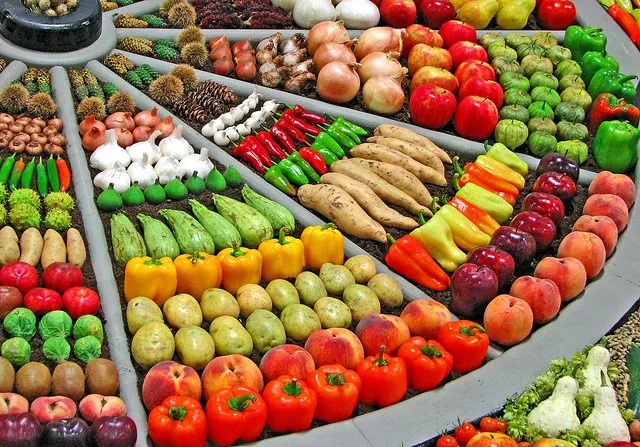Blog
The Meaning Behind the Color of Your Food
By Lisa Kaschmitter, Arizona State University Nutrition Student
When we chose to Fill Our Plate with fresh fruits and veggies, we often find that our plates look like a rainbow. There are blues, greens, purples, yellows, oranges, and reds naturally occurring in these foods, but what do these colors signify, and what do they tell you about the vitamins, minerals, and health benefits filling your plate?

(Photo: https://farm5.staticflickr.com/4152/5023325968_2fdae12731_z.jpg)
The pigment that a food item carries comes, in part, from the phytochemicals that it contains, according to Juliann Schaeffer in Today’s Dietitian, “Color Me Healthy – Eating for a Rainbow of Benefits.” This coloring tells us a little bit about what we can expect nutritionally from these foods. Although the majority of phytochemicals are colorless, the ones that add color give us a head start to making sure our diets are providing the variety of vitamins and minerals that we need, Schaeffer also suggests.
Red: Lycopene creates the red pigment in foods like peppers, tomatoes, and watermelon. The relationship between lycopene and many positive health impacts has been well documented. Lycopene has been shown to reduce cancer incidences, specifically prostate and pancreatic cancer risks, according to a variety of medical sources. Other recent research has shown preliminary links between lycopene and cardiovascular health because it keeps bad cholesterol (low-density liproprotein (LDL)) from hardening your arteries. Tomatoes are widely thought of as one of the best food sources of lycopene and cooked tomatoes, such as in marinara sauce, make the lycopene content easier for our bodies to absorb.
Orange and Yellow: The orange and yellow pigments that are found in fresh foods are a sign that beta-cryptoxanthin is present. Beta-cryptoxanthin plays a key role in the communication process between cells. It prevents oxidative damage from impacting tissues and organs. It is also crucial in the formation of Vitamin A. Vitamin A is essential for proper growth and development, while also keeping our eyesight and immune system strong. Beta-cryptoxanthin can be found in foods such as carrots, tangerines, sweet potatoes, and cantaloupe, according to Today’s Dietitian.
Green: Often leafy greens are the first thing thought of when we think of healthy foods. This reputation is spot on. Green fruits and vegetables contain vitamins and minerals that are essential for our health, they even have a large role to play before we are born. Green vegetables, such as spinach, contain high amounts of folic acid. Folic acid is key to the development of neural tubes during pregnancy. Green fruits and vegetables also contain Vitamin K and potassium, both of which work together with folic acid to promote healthy blood and heart functioning. Vitamin K plays a role in blood clot formation, while potassium can help regulate blood pressure.
Purples and Blues: What do eggplant, red wine, and strawberries all have in common? They all have a rich purple, blue, or scarlet coloring, of course, but they also have high levels of anthocyanin. Anthocyanin is a flavonoid responsible for these pigments and it also seems to serve an important purpose in our bodies. Researchers agree that eating more of these fruits and vegetables may be a return to our hunter/gatherer eating habits, which means that our bodies function best when anthocyanin is included in our diets. Since the 1980s, scientists have attempted to provide a link between anthocyanin and its health impacts. It has been difficult for them to prove a definitive link, since anthocyanins are available in a many different fruits and vegetables. Researchers are more able to study the impacts of specific foods that are known to be high in anthocyanin, such a blueberries. Blueberries promote heart health and may help to regulate blood pressure.
Keep the importance of all these colors in mind the next time you are at the grocery store, get a range of colors in your basket, so that you can get a range of colors on your plate. Keep in mind that the color does not tell you everything about the phytochemical content of your food, but it is a good place to start when forming a well balanced diet.
You can discover a variety of this color for your plate by going to Fill Your Plate.
















